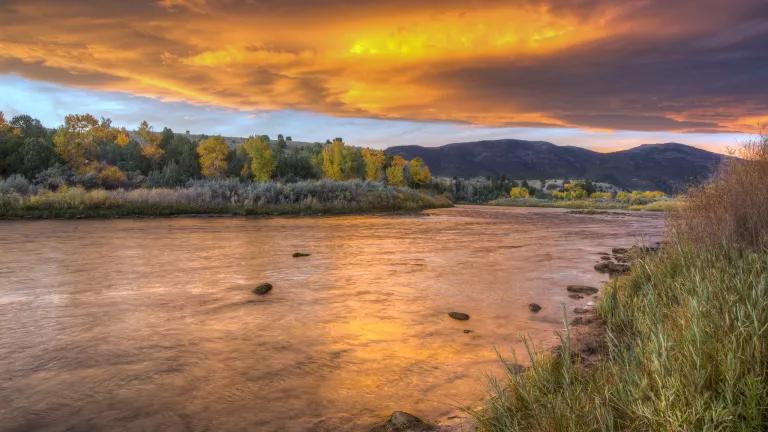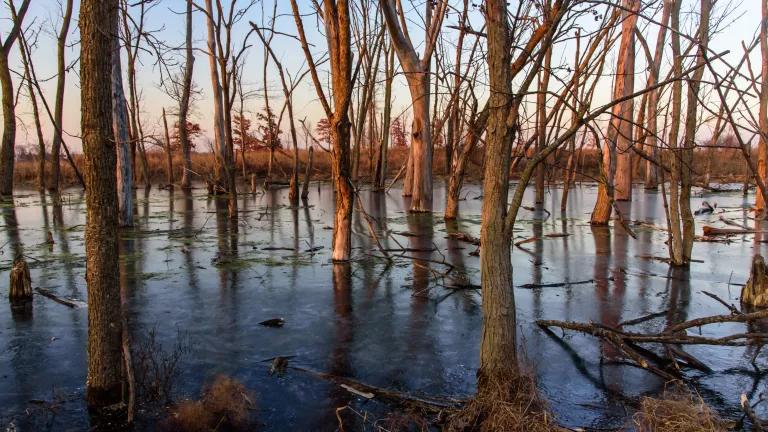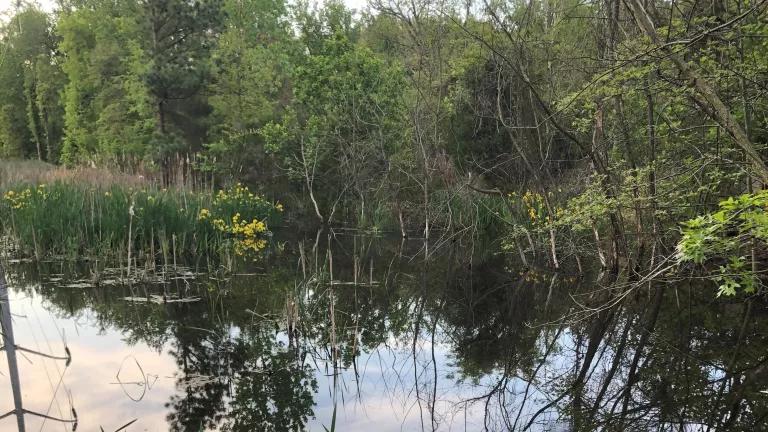Water, Water Everywhere and Not a Drop to Waste
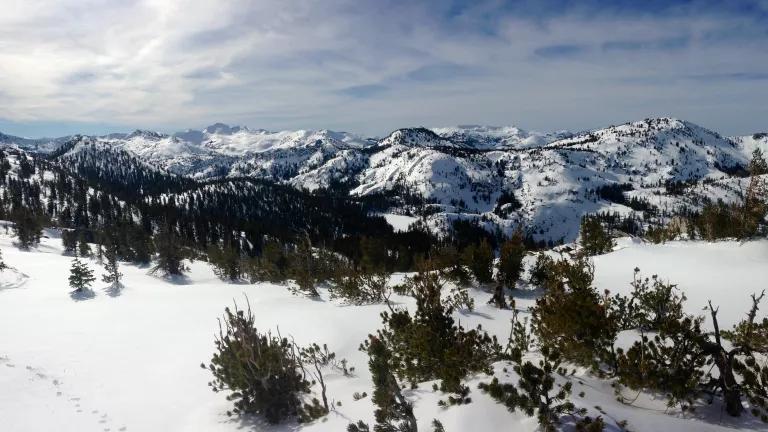
Desolation Wilderness sporting its 2017 winter coat. The abundant snowfall has been greatly appreciated across the state, not just by ski towns, but also the farming and fishing communities that depend on the spring and summer snowmelt. Yet this relief will dissipate as quickly as the snow if we fail to manage our water more sustainably. Photo: Anna Wearn.
What the Sierra Nevada snow survey says about the drought and California’s water future
Guest blog by Anna Wearn, Water Program, NRDC
The results are in: California’s snowpack is 164% of average, according to the latest Sierra Nevada snow survey.
The 45.8 inches of water content measured today—when the state’s snowpack typically peaks—is good news for a state that relies on this “natural reservoir” for one-third of its water supply. But California cannot afford to let up on efforts to achieve much needed reforms to the way we manage our water.
What it means
California is still officially in a drought emergency, but surface water supplies are certainly in better shape after this winter’s storms. The estimates of upcoming runoff are well above average and most reservoirs are near, at, or above capacity and percent average storage.
Yet drought is not just a result of the water Mother Nature supplies in a given year; it also reflects a mismatch between our long-term water supply and demand. Decades of excessive groundwater pumping have depleted our aquifers and 2017’s precipitation cannot fill the gaping hole left behind … a hole so big that some experts say we’ll never recover. Our groundwater supplies remain 10 million-acre feet below their pre-drought levels, due to the insatiable straw of an agricultural industry that, as hydrologist Jay Famiglietti explains, “will never be satisfied by the annual winter storms.”
Those who bear the greatest burden are the rural communities of the Central Valley who can’t afford to dig deeper and deeper wells to access safe drinking water. But we all pay the price for the resulting damage to bridges, roads, and canals as the land below this public infrastructure subsides at a rate of up to two feet per year with over-pumping drawing the water table down.
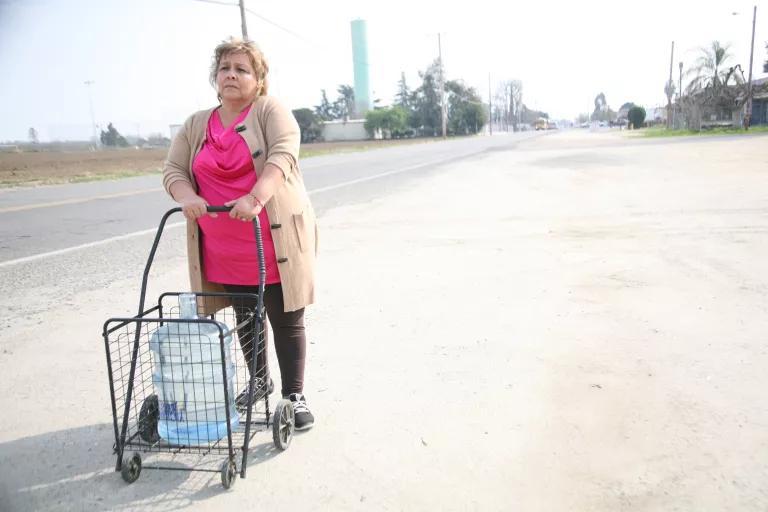
Preparing for the future
We know that the recent pattern of hot, dry years will return. Reflecting on lessons learned from the drought, the Chairwoman of the State Water Resources Control Board warned:
“There will be a next time, and this time isn’t over yet for a lot of Californians. Certainly isn’t for fish and wildlife.”
Indeed, California’s climate is more variable than any other state. Furthermore, climate scientists predict that the frequency of droughts will increase and snowfall will decrease, with Sierra Nevada snowpack levels as low as 2015's (a meager 5% of average) occurring every decade.
It’s time to pivot our water management policy from frantic reactions to each successive water crisis and towards proactively planning for these extremes as the new normal. This means investing in 21st century solutions for a sustainable water supply and improving the health of California’s main water hub.
1) Using water more wisely
In 2015, NRDC published A Report Card on California’s Response to the Drought, demonstrating how the state has made strides in regards to urban water conservation, efficiency, and recycling, while highlighting the need for significant improvements to our management of the Bay-Delta Estuary, agricultural water use, and stormwater capture. These reforms will be critical to reducing the stress on our over-drafted groundwater basins and deteriorating ecosystems.
The state is currently finalizing a framework that seeks to continue to move the ball forward on conservation and efficiency, our most cost-effective water supply options. The report presents a path for implementation of Governor Brown’s May 2016 executive order to make conservation a way of life in California. The plan has the potential to reduce pressure on water supplies and enhance long-term water security by encouraging more efficient agricultural and urban water use and drought planning.
Several corollary measures will help achieve the state’s objectives. We need legislation that improves the urban, rural, and agricultural water use planning process, establishes new water use targets for urban suppliers, and promotes stormwater capture, water recycling and reuse. And it is time to modernize our agricultural water systems to improve water delivery and irrigation efficiency, and to adopt policies that improve soil health so that cropland can retain more water.
2) Reducing diversions from the Bay-Delta Estuary
As California’s snowpack melts each spring, much of it flows from the Sierra Nevada Mountains to the San Francisco Bay-Delta. This estuary is the largest on the west coast of the Americas and a major source of water supply for the state—providing drinking water for more than 25 million Californians and irrigation water for more than 3 million acres.
But we have been draining the estuary of too much of its fresh water flows, causing the health of the ecosystem and its native fish and wildlife populations to decline dramatically, and threatening thousands of fishing jobs. In 2009 the State Water Resources Control Board began to update water quality and flow standards in the Bay-Delta to protect agriculture, cities, and the environment. This year the state is expected to adopt new flow standards for the lower San Joaquin River basin, to be followed in the coming year by new flow and water quality standards for the Sacramento River and Delta.
Until we learn to align water demands with the amount we can reliably supply, we will suffer through perpetual water shortages. Water may appear to be in abundance right now. But wisely using every drop and being better stewards of our natural supplies will be critical to securing a sustainable water future for California’s people, economy, and environment.

